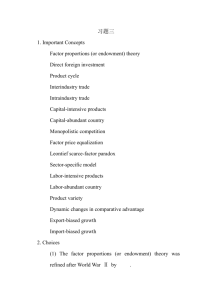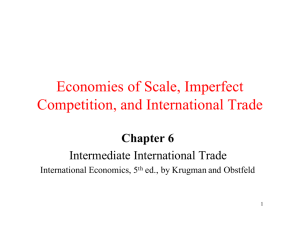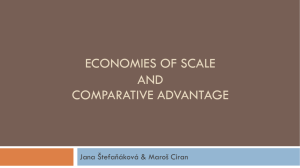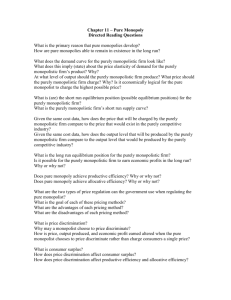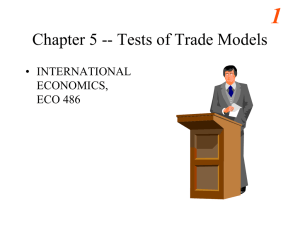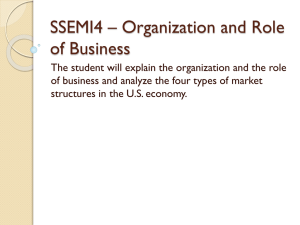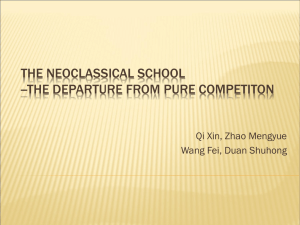Economies of Scale 2
advertisement
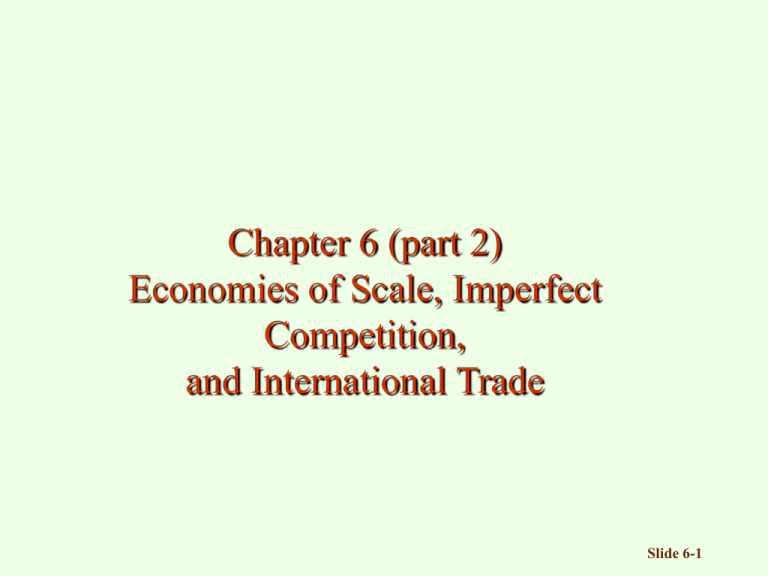
Chapter 6 (part 2) Economies of Scale, Imperfect Competition, and International Trade Slide 6-1 Equilibrium in a Monopolistically Competitive Market Negative Relationship between Number of firms (n) and Price charged by the firm (P) PP: P = c + 1/(b x n) The more firms there are in the industry, the lower the price each firm will charge Average cost depends on the size of the market and the number of firms in the industry: CC: AC = F/Q + c = n x F/S + c The more firms there are in the industry the higher is the average cost. 2 The Theory of Imperfect Competition Figure 6-3: Equilibrium in a Monopolistically Competitive Market Cost C, and Price, P CC AC3 P1 E P2, AC2 AC1 P3 PP n1 n2 n3 Number of firms, n Slide 6-3 The Theory of Imperfect Competition – A particular equation for the demand facing a firm that has these properties is: Q = S x [1/n – b x (P – P)] (6-5) where: – Q is the firm’s sales – S is the total sales of the industry – n is the number of firms in the industry – b is a constant term representing the responsiveness of a firm’s sales to its price – P is the price charged by the firm itself –P is the average price charged by its competitors Slide 6-4 Monopolistic Competition and Trade The monopolistic competition model can be used to show how trade leads to: • A lower average price due to scale economies • The availability of a greater variety of goods due to product differentiation • Imports and exports within each industry (intraindustry trade) Slide 6-5 Monopolistic Competition and Trade The Effects of Increased Market Size • The number of firms in a monopolistically competitive industry and the prices they charge are affected by the size of the market. As a country opens up to free trade, the market size increases: S (total sales of the industry) captures the market size • CC : AC= F/Q + c = n x F/S + c • PP: P = c + 1/(b x n) Slide 6-6 Monopolistic Competition and Trade Figure 6-4: Effects of a Larger Market Cost C, and Price, P CC1 CC2 1 P1 2 P2 PP n1 n2 Number of firms, n Slide 6-7 Monopolistic Competition and Trade Gains from an Integrated Market: A Numerical Example • International trade allows creation of an integrated market that is larger than each country’s market. – It thus becomes possible to offer consumers a greater variety of products and lower prices. Slide 6-8 Monopolistic Competition and Trade • Example: Suppose that automobiles are produced by a monopolistically competitive industry. – Assume the following: – – – – b = 1/30,000 F = $750,000,000 c = $5000 There are two countries (Home and Foreign) that have the same costs of automobile production. – Annual sales of automobiles are 900,000 at Home and 1.6 million at Foreign. Slide 6-9 Monopolistic Competition and Trade Figure 6-5: Equilibrium in the Automobile Market Slide 6-10 Monopolistic Competition and Trade Figure 6-5: Continued Slide 6-11 Monopolistic Competition and Trade Figure 6-5: Continued Slide 6-12 Monopolistic Competition and Trade Table 6-2: Hypothetical Example of Gains from Market Integration Slide 6-13 Monopolistic Competition and Trade Economies of Scale and Comparative Advantage • Assumptions: – There are two countries: Home (the capital-abundant country) and Foreign. – There are two industries: manufactures (the capitalintensive industry) and food. – Neither country is able to produce the full range of manufactured products by itself due to economies of scale. Slide 6-14 Monopolistic Competition and Trade Figure 6-6: Trade in a World Without Increasing Returns Home (capital abundant) Manufactures Food Foreign (labor abundant) Slide 6-15 Monopolistic Competition and Trade • If manufactures is a monopolistically competitive sector, world trade consists of two parts: – Intraindustry trade – The exchange of manufactures for manufactures – Interindustry trade – The exchange of manufactures for food Slide 6-16 Monopolistic Competition and Trade • Main differences between interindustry and intraindustry trade: – Interindustry trade reflects comparative advantage, whereas intraindustry trade does not. – The pattern of intraindustry trade itself is unpredictable, whereas that of interindustry trade is determined by underlying differences between countries. – The relative importance of intraindustry and interindustry trade depends on how similar countries are. Slide 6-17 Monopolistic Competition and Trade The Significance of Intraindustry Trade • About one-fourth of world trade consists of intraindustry trade. • Intra-industry trade plays a particularly large role in the trade in manufactured goods among advanced industrial nations, which accounts for most of world trade. Slide 6-18 Monopolistic Competition and Trade Table 6-3: Indexes of Intraindustry Trade for U.S. Industries, 1993 Slide 6-19 Monopolistic Competition and Trade Why Intraindustry Trade Matters • Intraindustry trade allows countries to benefit from larger markets. – The case study of the North American Auto Pact of 1964 indicates that the gains from creating an integrated industry in two countries can be substantial. • Gains from intraindustry trade will be large when economies of scale are strong and products are highly differentiated. – For example, sophisticated manufactured goods. Slide 6-20 The Theory of External Economies Economies of scale that occur at the level of the industry instead of the firm are called external economies. There are three main reasons why a cluster of firms may be more efficient than an individual firm in isolation: • Specialized suppliers • Labor market pooling • Knowledge spillovers Slide 6-21 The Theory of External Economies Specialized Suppliers • In many industries, the production of goods and services and the development of new products requires the use of specialized equipment or support services. • An individual company does not provide a large enough market for these services to keep the suppliers in business. – A localized industrial cluster can solve this problem by bringing together many firms that provide a large enough market to support specialized suppliers. – This phenomenon has been extensively documented in the semiconductor industry located in Silicon Valley. Slide 6-22 The Theory of External Economies Labor Market Pooling • A cluster of firms can create a pooled market for workers with highly specialized skills. • It is an advantage for: – Producers – They are less likely to suffer from labor shortages. – Workers – They are less likely to become unemployed. Slide 6-23 The Theory of External Economies Knowledge Spillovers • Knowledge is one of the important input factors in highly innovative industries. • The specialized knowledge that is crucial to success in innovative industries comes from: – Research and development efforts – Reverse engineering – Informal exchange of information and ideas Slide 6-24
